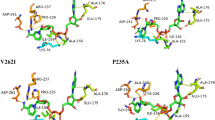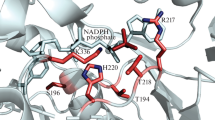Abstract
Pseudomonas aeruginosa phosphorylcholine phosphatase (PChP), the product of the PA5292 gene, is synthesized when the bacteria are grown with choline, betaine, dimethylglycine, or carnitine. In the presence of Mg2+, PChP catalyzes the hydrolysis of both phosphorylcholine (PCh) and p-nitrophenylphosphate (p-NPP). PCh saturation curve analysis of the enzyme with or without the signal peptide indicated that the peptide was the fundamental factor responsible for decreasing the affinity of the second site of PChP for PCh, either at pH 5.0 or pH 7.4. PChP contained three conserved motifs characteristic of the haloacid dehalogenases superfamily. In the PChP without the signal peptide, motifs I, II, and III correspond to the residues 31DMDNT35, 166SAA168, and K242/261GDTPDSD267, respectively. To determine the catalytic importance of the D31, D33, T35, S166, K242, D262, D265, and D267 on the enzyme activity, site-directed mutagenesis was performed. D31, D33, D262, and D267 were identified as the more important residues for catalysis. D265 and D267 may be involved in the stabilization of motif III, or might contribute to substrate specificity. The substitution of T35 by S35 resulted in an enzyme with a low PChP activity, but conserves the catalytic sites involved in the hydrolysis of PCh (Km1 0.03 mM, Km2 0.5 mM) or p-NPP (Km 2.1 mM). Mutating either S166 or K242 revealed that these residues are also important to catalyze the hydrolysis of both substrates. The substitution of lysine by arginine or by glutamine revealed the importance of the positive charged group, either from the amino or guanidinium groups, because K242Q was inactive, whereas K242R was a functional enzyme.

Similar content being viewed by others
Literature Cited
Alfarano C, Andrade CE, Anthony K, et al. (2005) The biomolecular interaction network database and related tools 2005 update. Nucleic Acid Res 33:D418–D424
Altschul SF, Madden TL, Schaffer AA, et al. (1997) Gapped BLAST and PSI-BLAST: a new generation of protein database search programs. Nucleic Acid Res 25:3389–3402
Bendtsen JD, Gunnar von Heijne HN, Brunak S (2004) Improved prediction of signal peptides: SignalP 3.0. J Mol Biol 340:783–795
Bradford M (1976) A rapid and sensitive method for quantitation of microgram quantities of protein utilizing the principle of protein-dye binding. Anal Biochem 72:248–254
Domenech CE, Lisa TA, Salvano MA, et al. (1992) Pseudomonas aeruginosa acid phosphatase: activation by divalent cations and inhibition by aluminium ion. FEBS Lett 1:96–98
Fiske C, Subarrow Y (1925) The colorimetric determination of phosphorous. J Biol Chem 66:361–375
Guex N, Peitsch MC (1997) SWISS-MODEL and the Swiss-PdbViewer: an environment for comparative protein modeling. Electrophoresis 18:2714–2723
Houston B, Stewart AJ, Farquharson C (2004) PHOSPHO1-A novel phosphatase specifically expressed at sites of mineralisation in bone and cartilage. Bone 34:629–663
Kelley LA, MacCallum RM, Sternberg MJE (2000) Enhanced genome annotation using structural profiles in the program 3D-PSSM. J Mol Biol 299:499–520
Koonin EV, Tatusov RL (1994) Computer analysis of bacterial haloacid dehalogenases defines a large superfamily of hydrolases with diverse specificity. Application of an iterative approach to database search. J Mol Biol 244:125–132
Lisa TA, Casale CH, Domenech CE (1994) Cholinesterase, acid phosphatase and phospholipase C of Pseudomonas aeruginosa under hyperosmotic conditions in a high-phosphate medium. Curr Microbiol 28:71–76
Lisa AT, Lucchesi GI, Domenech CE (1994) Pathogenicity of Pseudomonas aeruginosa and its relationship to the choline metabolism through the action of cholinesterase, acid phosphatase and phospholipase C. Curr Microbiol 29:193–199
Lucchesi GI, Lisa AT, Casale CH, et al. (1995) Carnitine resembles choline in the induction of cholinesterase, acid phosphatase, and phospholipase C and in its action as an osmoprotectant in Pseudomonas aeruginosa. Curr Microbiol 30:55–60
Massimelli MJ, Beassoni PR, Forrellad MA, et al. (2005) Identification, cloning and expression of Pseudomonas aeruginosa phosphorylcholine phosphatase gene. Curr Microbiol 50:251–256
Roberts SJ, Stewart AJ, Sadler PJ, et al. (2004) Human PHOSPHO1 exhibits high specific phosphoethanolamine and phosphocholine phosphatase activities. Biochem J 382:59–65
Salvano MA, Domenech CE (1999) Kinetic properties of purified Pseudomonas aeruginosa phosphorylcholine phosphatase indicated that this enzyme may be utilized by the bacteria to colonize in different environments. Curr Microbiol 39:1–8
Selengut JD, Levine RI (2000) MDP−1: a novel eukaryotic magnesium dependent phosphatase. Biochemistry 39:8315–8324
Stewart AJ, Schmid R, Blindauer CA, et al. (2003) Comparative modeling of human PHOSPHO1 reveals a new group of phosphatases within the haloacid dehalogenase superfamily. Protein Eng 16:889–895
Thompson JD, Gibson TJ, Plewniak F, et al. (1997) The ClustalX-Windows interface: flexible strategies for multiple sequence alignment aided by quality. Nucleic Acid Res 25:4876–4882
Wang W, Cho SH, Kim R, et al. (2002) Structural characterization of the reaction pathway in phosphoserine phosphatase: crystallographic “snapshots” of intermediate states. J Mol Biol 319:421–431
Wang W, Kim R, Jancarik J, et al. (2001) Crystal structure of phosphoserine phosphatase from Methanococcus janaschii a hyperthermophile, at 1.8 Å resolution. Structure.9:65–71
Acknowledgments
CED and ATL are Career Members of the Consejo Nacional de Investigaciones Cientificas y Técnicas (CONICET). PRB and MJM have a fellowship from CONICET and LHO from CONICET-ACC. This work was supported by grants from CONICET, Agencia Córdoba Ciencia, ANPCYT-UNRC, and SECYT-UNRC of Argentina.
Author information
Authors and Affiliations
Corresponding author
Rights and permissions
About this article
Cite this article
Beassoni, P.R., Otero, L.H., Massimelli, M.J. et al. Critical Active-Site Residues Identified by Site-Directed Mutagenesis in Pseudomonas aeruginosa Phosphorylcholine Phosphatase, A New Member of the Haloacid Dehalogenases Hydrolase Superfamily. Curr Microbiol 53, 534–539 (2006). https://doi.org/10.1007/s00284-006-0365-2
Received:
Accepted:
Published:
Issue Date:
DOI: https://doi.org/10.1007/s00284-006-0365-2




